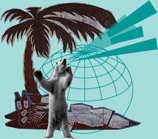Act 3: The Faroe Islands, May 12 – June 4, 2006
ART EXHIBITION
Living (in) the Postcolonial
The Faroe Islands Art Museum, Tórshavn
May 12 – June 4, 2006
Opening Friday, May 12, 2006, 5 – 8 pm
Press Preview Friday, May 12, 2006, 2 – 4 pm
This exhibition locates and analyzes impacts of imperial dynamics on our bodies and minds. It will address how we internalize ideas of difference and normality. Re-reading colonial history and present-day lives, it examines how individuals and communities use language and performance to come up with viable strategies for understanding and resisting imperialism in its different guises.
The exhibition is accompanied by the film program Silver Screen Resistance (for screening hours and participant information, click here).
PARTICIPATING ARTISTS
Pia Arke (Greenland/Denmark)
Nadiah Bamadhaj (Malaysia/Indonesia)
Godfried Donkor (Ghana/United Kingdom)
Jane Jin Kaisen & Tobias Hübinette (South Korea/Denmark & South Korea/Sweden)
Rannvá Holm Mortensen (The Faroe Islands)
Ruangrupa (Indonesia)
FILM PROGRAM PARTICIPANTS
Stephanie Black (USA)
Randi Broberg in collaboration with Tine Bryld (Greenland/Denmark & Denmark)
Laila Hansen (Greenland)
Isaac Julien (United Kingdom)
Alanis Obomsawin (Abenaki, Canada)
Pratibha Parmar (Kenya/United Kingdom)
Gillo Pontecorvo (Italy)
Paul-Anders Simma (Sámi, Norway/Sweden/Finland)
Address/Hours/Admission:
Gundadalsvegur 9, 110 Tórshavn
t: +298 31 35 79, e: info@art.fo, www.art.fo
Tuesday – Friday, 11 am – 4 pm, Saturday – Sunday, 2 – 5 pm
Admission: adults DKK 60, children under 12 years and school classes free,
pensioners/students/groups of ten DKK 40
PIA ARKE
Born 1958 in Scorebysund, Greenland. Lives and works in Copenhagen, Denmark.
Pia Arke is a visual artist, who works with photography and text primarily. She graduated from the Royal Danish Academy of Fine Arts in Copenhagen in 1993 and holds two additional degrees from that institution: a Cand.Phil. in Art Theory from the Department of Art Theory and a Multimedia Design degree from the School of Media Arts. Arke has exhibited in a large number of contexts and has completed several public art commissions for the Danish Polar Center, the Ministry of Defence, and the Environmental Investigations of Denmark, among others. Arke is the recipient of the 1999 award from the Danish Arts Foundation and in 2000, she received a 3-year work grant from the Danish Arts Foundation.
Pia Arke participates with the original score for her photographic book Scoresbysundhistorier. Fotografier, kolonisering og kortlægning (Scoresbysund Stories: Photographs, Colonization, Mapping), which was published by Borgens Forlag in Copenhagen, 2003. In an essay on Arke, art critic Mette Sandbye writes: “Pia Arke was born 1958 in Greenland by a Greenlandic mother and a Danish father, who worked as a telegraphist. Most of her art projects deal with her Greenlandic background. Not in a private and introverted manner, but rather on a typological level and as a starting point for dealing with the postcolonial, the history of Greenland, and the meeting between Danes and Greenlanders. […] Scorebysundhistorier was the culmination of several years of artistic work and cultural-historical research on the village, where many of her relatives still live today. More than half of the book consists of text, and most of the book’s photographs are found in archives, especially photographs taken by Danish colonizers. Since photography as a medium is bound to the idea of taking into possession and of conquering, the history of photography and the history of colonialism as such are closely connected. Scorebysund with its 600 inhabitants is located on the rough and almost uninhabited North Eastern coast of Greenland. The closest neighbour is the small military unit Daneborg located 400 km to the North, whereas the closest ‘city’ is Angmagssalik, which has 1,700 inhabitants and is located 1,000 km to the South. In the 1920s, the Danes fought the Norwegians on the right to North Eastern Greenland. As an important initiative in this territorial war, ten Greenlandic sealer families from Angmagssalik were in 1925 invited to settle in Scorebysund with promise of a better life. Pia Arke’s mother’s parents were among them and her mother was thus born and raised in the village. One day, Pia Arke came across an article on Scorebysund in a provincial newspaper with the title ‘Close the village without a future!’ It is information on and experiences from this village without a past and without a future that the artist brings to light in her book. The book is composed as a kind of collage of archival photographs, quotations from all sorts of (sometimes quite curious and at times almost hair-raising) primary sources, the author’s reflections, and information from the large number of interviews she conducted (for instance, in the village’s residential home where she asks the elderly residents to identify and tell about the many unnamed Greenlanders in the Danes’ photographs.” [Excerpt from text written by Mette Sandbye for the book Manual til dansk samtidskunst by Lisbeth Bonde & Mette Sandbye, forthcoming at Gyldendal, autumn 2006]
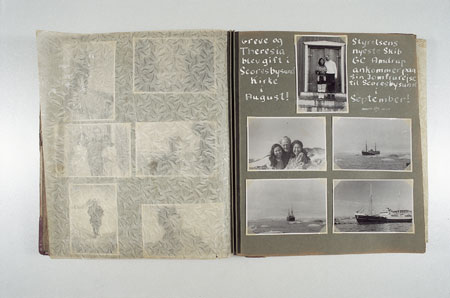
Pia Arke, “Dummy,” 1993.
Original score from the photographic book Scoresbysundhistorier. Fotografier, kolonisering og kortlægning
(Scoresbysund Stories: Photographs, Colonization, Mapping), 2003.
Mixed media, 300 x 200 cm. Courtesy of the artist.
NADIAH BAMADHAJ
Born 1968 in Petaling Jaya, West Malaysia. Currently lives and works in Yogyakarta, Indonesia.
Nadiah Bamadhaj was born in Petaling Jaya, West Malaysia in 1968. Trained as a sculptor, she now produces installations of drawings, video, and digital images. She has worked in non-government organizations on HIV/AIDS prevention, human rights advocacy, and more recently lectured at the Center for Advanced Design in Kuala Lumpur. She is author of Aksi Write (1997), a work of non-fiction on Indonesia and East Timor, co-written with her late brother. In 2000, she began full-time art practice, and was awarded the Nippon Foundation’s Asian Public Intellectual Fellowship in 2002, choosing to spend her yearlong fellowship period in Yogyakarta, Indonesia, where she currently lives. Her recent artwork looks at architecture as historical documents and carriers of memory, which is the topic of her Ph.D. research that begins in 2006.
For Act 3 of Rethinking Nordic Colonialism, Nadiah Bamadhaj produces a series of digital and video works titled “Bestowed upon you, is this departure.” The project introduces elements of Malaysian and Indonesian architecture and literature into the Faroese landscape. Her selection of architecture and literature is based on how in an attempt to embark from the elements of European colonization of the previous centuries; it inadvertently mirrors the grandeur and the social and symbolic alienation of those colonial structures. Ironically, this renders it both incongruous to its surroundings and a form of colonization in its own right.
The artist pushes this idea of “continued colonialism” by incorporating these forms and texts into the Faroese landscape. The incongruity of these architectural forms and written text in the Faroese landscape acts as a metaphor for how these forms are perceived by the artist in their original state. And the imagined political colonization of the Faroese by Malaysia and/or Indonesia is an attempt to reflect how the artist perceives the mechanizations of government in her own national and residential experience. Postcolonial departures are perceived by the artist as a continued colonization in different form, and – in this case – different spaces. [Nadiah Bamadhaj]

Nadiah Bamadhaj, “Putrajaya” from the “147 years of independence” series, 2005.
Photo, dimensions variable. Courtesy of the artist.
GODFRIED DONKOR
Born 1964 in Kumasi, Ghana. Lives and works in London, United Kingdom.
Godfried Donkor was born in Kumasi in Ghana. He attended Central St. Martins’ College of Art and Design in London (1989), and pursued postgraduate work in Barcelona (1991). He holds a MA in African Art History from the School of Oriental and African Studies (SOAS), University of London (1996). His visual art practice incorporates the mediums of painting, printmaking, collages, photography, and more recently film/performance. He has been in the international art circuit since 1996 and has participated in residency programs in a number of key spaces in Africa, Europe, the US, and the Caribbean. These are also the spaces that inform and create visual material for his work. Using memory, history, and the notion of aesthetics as a source of creative visual references, his work is often noted to allude to the experience of “déjà-vu.”
Selected group exhibitions include: Pin Up (Tate Modern, London, 2004), Collection of the Spanish Sports Council, Ses Voltes (Palma de Mallorca, 2005), We Two Together: GHANA.NIGERIA: OLADAPO & GODFRIED DONKOR (National Theatre, Accra, Ghana, 2004), Bling Bling (London Print Studio, London, 2004), Copy it, steal it, share it (Borusan Art Gallery, Istanbul Biennale, 2003), BIDA, Biennale of Sports and Art (Salamanca, Spain, 2003), A Fiction of Authenticity: Contemporary Africa Abroad (Contemporary Art Museum, St. Louis, 2003), 1st Flag (Casino, Luxembourg, 2003), Transferts (La Palais Des Beaux Artes, Brussels, 2003), Body Power/Power Play (Wurttenbergische Kunstverein, Stuttgart, 2002), Populated (IASPIS Gallery, Stockholm, 2002), Bartimeus Prize exhibition (National Theatre, Ghana, 2001), Sports Cult (Apex Art Curatorial Program, New York, 2001), Authentic/Excentric (African Pavilion, Venice Biennale, 2001), Africa Today: The Artist and the City (Barcelona, 2001), The 7th Havana Biennale (Havana, Cuba, 2000), World Trade (Roebling Hall Gallery, New York, 2000), Big River – International Artists’ Exhibition (Trinidad & Tobago, 1999), Routes, Five artists (Brunei Gallery, London, 1999), Cinco Continentes y uno Ciudad Salon exhibition (Mexico City, Mexico, 1998), Dak’ Art 98 (Dakar, Senegal, 1998).
Selected solo exhibitions include: Jamestown Masquerade (Metalwork Gallery, St. Croix, US Virgin Islands, 2006), Concerto in Light and Darkness No. 1 (National Museum, Ghana, 2005), Godfried Donkor (Pascal Polar Gallery, Brussels, 2004), Financial Times (Ecole Regionale des beaux Artes, Nantes, France, 2004), The Fancy (Stephen Lawrence Gallery, London, 2003), Godfried Donkor: Recent Works (The Scene Gallery, NY, 2003), Godfried Donkor (Albrecht Dürer Kunstverein, Nuremberg, Germany, 2002), Artists in Residence Exhibition (IASPIS, Stockholm), Whose Africa (Horniman Museum, London, 2000), Wrestling and Mysticism (Dak’ Art 2000, Dakar, Senegal, 2000), Jamestown Masquerade (Jamestown, Ghana, 2005). Currently working on solo and group projects in St. Croix, Amsterdam, London, Houston, and Ghana.
Godfried Donkor participates with a new installation titled “In the age of Enlightenment.” He writes about the project: “The installation is a mixture of old work and new work. It includes mixed media work as well as prints, painting, and collages on canvas and in various sizes. The walls of the space will be covered with wallpaper or painted in Regency style. All the pieces will be mounted in gold gilded frames, around 14-18 of them. The installation will be presented as a stage for the viewer to walk into; a space which reviews cultural memory as a residue of the immediate moment. This piece seeks to explore the ‘duel consciousness’ of our present transcultural spaces through a visual quest.” [Godfried Donkor]
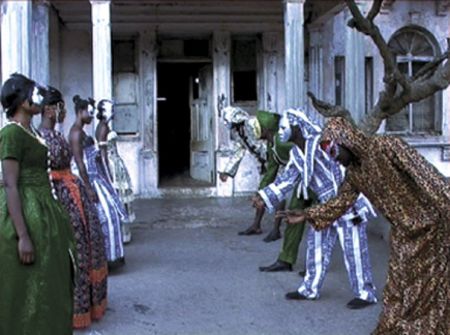
Godfried Donkor, “Jamestown Masquerade,” 2005.
Video still. Courtesy of the artist.
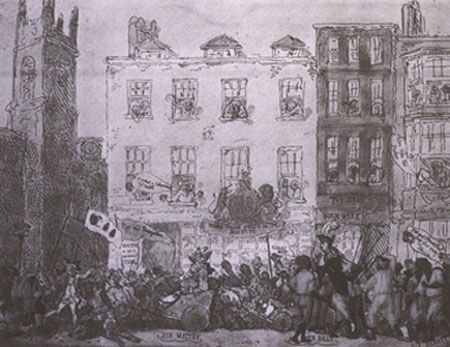
Godfried Donkor, “London Mob,” 2001.
Mixed media collage on paper, 48 x 64 cm.
Courtesy of the artist.
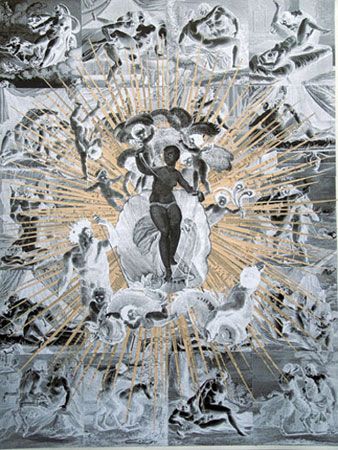
Godfried Donkor, “The Birth of Venus,” 2003.
Mixed media collage on paper, 48 x 64 cm.
Courtesy of the artist.
JANE JIN KAISEN & TOBIAS HÜBINETTE
Born 1980 in Seoul, South Korea. Lives and works in Copenhagen, Denmark.
Born 1971 in Cheonju, South Korea. Lives and works in Stockholm, Sweden.
Jane Jin Kaisen is a visual artist and activist working in an interdisciplinary manner with video, performance, text, and photography. In an attempt to deconstruct narration, reading, and representation, she uses reversed strategies and multilayered approaches in her use of language and medium. She is part of Chamber of Public Secrets, a mobile art apparatus that produces video documentaries/broadcasting for the Copenhagen-based tv-tv and has organized Made In Video: International Video Art Festival on Public Secrets and Visual Representation in Copenhagen, 2006. She was co-curator of International Adoptee Gathering Exhibition (Seoul, South Korea, 2004), co-founder of UFOlab (Unidentified Foreign Object Laboratory), a Scandinavian-based artist/activist group working with postcolonial and feminist theory for international adoptees’ rights through seminars, exhibitions, city interventions, and writing. Kaisen is also part of the exhibition collective Orientity of Diaspora Korean Artists, which exhibits and lectures on trans-experience.
Tobias Hübinette (Korean name Lee Sam-dol) is a Lecturer and Researcher in contemporary Korean culture and society at the Department of Oriental Languages, Stockholm University. His Ph.D. dissertation in Korean Studies, Comforting an Orphaned Nation, examines international adoption from Korea, the Korean adoption issue, and representations of adopted Koreans in Korean media and popular culture. He has lectured, published books and articles, and made research on Nazism and racism in the Scandinavian countries. In addition, he writes in Swedish, Korean, and international newspapers and journals on issues concerning (post)colonialism in a Nordic context and setting, and on international adoption and international adoptees in general. Other interests are Swedish and Western images and representations of Korea and East Asians, problems regarding Orientalism and Asianists, and marginalized postcolonial Diasporas and ethnic minorities.
Jane Jin Kaisen & Tobias Hübinette participate in Act 3’s exhibition with a new multimedia installation titled “Tracing Trades.” They describe the project as follows:
“…About Nordic Neo-Colonialism...it is very much a battle about history, not just how to view the history, but how to create the history. Why we came here...Why we are here... and why our children will be here… As adoption is portrayed in such a positive, anti-racist, and even anti-colonial way, our talk must be to remind Western people that they have done this before. For hundreds of years, they have done this. They have transported non-Western, non-white people in huge amounts and commodified them, and transported them forcefully.” (Quote from the “Tracing Trades” video)
Chasing and tracing the story behind the mysterious ‘Korean Man’ portrayed in a Rubens drawing, the quest takes several detours. From/to Minnesota and Tivoli in Copenhagen as well as to Denmark’s former colonies, ending up or beginning in an Alien Laboratory. A display of the observances – why there is something odd in the State of Denmark, particularly concerning a peculiar demographic disproportion of Asians in Scandinavia – will be present at the museum.
“There can be no healing without reconciliation. No reconciliation without recognition. For this recognition to take place, history must be once again dissected and re-constructed. Such a reconstruction can never be chronological, nor logical. As our memory and histories are per se concealed, it will always be fragmented and distorted. Yet, this memory of how we are doomed amnesiac, may be our healing and our very reason to sur-vive.” (AlieNated conversation from the “Tracing Trades” video)
We will also present an interventional performance. Part 1, ‘Transmitting: (Dis)ComfortAN(d)AlieNation,’ is performed in the Faroe Islands Art Museum on May 12 during the exhibition opening. Part 2, ‘(Dis)ComfortAN(d)AlieNation: The X-Raced Mut(at)ed Speak,’ is performed in the Nordic House on May 13 (click here for more info).” [Jane Jin Kaisen & Tobias Hübinette]
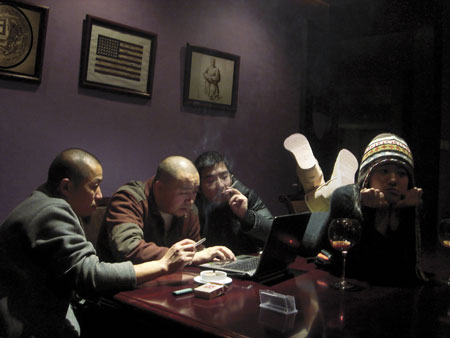
Jane Jin Kaisen, “Morpheme-Modification,” Beijing, 2005.
Photo, A1. Courtesy of the artist.
RANNVÁ HOLM MORTENSEN
Born 1950 in Tvøroyri, The Faroe Islands. Lives and works in Tórshavn, The Faroe Islands.
Rannvá Holm Mortensen has been active as an artist since the mid-1990s and has participated in various exhibitions, both in the Faroe Islands and abroad, for instance Denmark, Sweden, Iceland, and Spain. She is a self-taught artist and member of the union Føroysk Myndlistafólk. She has experimented with different forms and media a great deal, and for the last five years she has focused specifically on graphic collage, which for her is a crucial artistic tool for examining contemporary processes.
Rannvá Holm Mortensen participates with a new work, which she describes as follows: “My visual idea for Rethinking Nordic Colonialism is expressed in a large, fragmented picture, which is installed as a kind of installation. The work is composed of different pictures of various sizes and measures 10 x 2 meters in total. The work is a kind of collage composed of photos, graphics, painting, and other media on canvas mounted on strong stretchers. This form of expression allows me to work with details, which I find crucial in my examination of colonialism. The work addresses different problematics of colonialism from a feminist perspective. First of all, how colonialism affects the two sexes differently and how the two sexes experience colonialism in a different manner. Secondly, how the Faroe Islands as a colony in the Realm of Denmark has involuntarily become part of NATO and the invasion of Iraq. The work will also address interactions between the Faroe Islands, Greenland, and Denmark. In other words, I am attempting to inscribe our micro cosmos in a larger context.” [Rannvá Holm Mortensen]
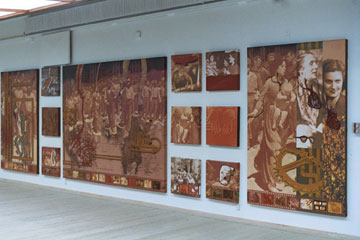
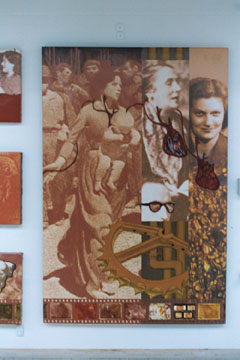
Rannvá Holm Mortensen, “Dage vil oprinde” (Days Will Come), 2003.
Collage on canvas/photo, graphics, painting. Installation in 12 parts, approximately 10 x 2 m.
Courtesy of the artist.
RUANGRUPA
Founded in 2000. Based in Jakarta, Indonesia.
Ruangrupa is an artists’ initiative founded in the year 2000 by a group of Jakarta-based artists. The group is a non-profit organization, which focuses on art and its relation to the social, cultural context – especially in the urban Jakarta environment – through research, study, and documentation. Ruangrupa conducts intensive collaborations and co-operations with artists and practitioners from other disciplines through exhibitions, an artist residency program, art projects, and workshops. They work with artists and other practitioners from both Indonesia and abroad. Their areas of interest count urban issues such as public space, housing, urban printing production, city government propaganda, students forum, local heros, etc. In addition to that, they also organize regular programs for the public: weekly video screenings, monthly discussions, and the publication of the art journal Karbon. Since 2003, they have organized the biannual OK.Video – Jakarta International Video Festival, whose program includes exhibitions, discussions, workshops, and collaborations. Ruangrupa also functions as an artists collaborative platform, which has produced a number of projects and exhibitions. For instance, Ruangrupa has participated in the Gwangju Biennale 2002, Jak@rt public art project, and the 9th International Istanbul Biennial (2005).
Ruangrupa participates with a new project titled “You’re Welcome,” which they describe as follows: “In this project, we will try to find different minority communities in the Faroe Islands organized around different backgrounds/interests such as race, ethnicity, religion, sexual orientation, sports, music, which have been marginalized because of the political/cultural view of the majority, but have somehow managed to survive and struggle and would like to have a more open environment. We are going to do research on text material that already exists – fables, song lyrics, poems, and other literature – from minority communities in the Faroe Islands. We will try to find a text about the community that is straight forward, metaphorical, or even funny, which can be used to remind both sides about their existence as a way to break or change the stereotypical image of the community and provide another perspective. This project will be more like a ‘warm regards’ gesture than a pretentious campaign or propaganda in order to promote better understanding and to get close to each other. The text will be spread to the public in the form of posters, T-shirts, postcards, pins, and other media, which are suitable at the site of the Faroe Islands.” [Ruangrupa]
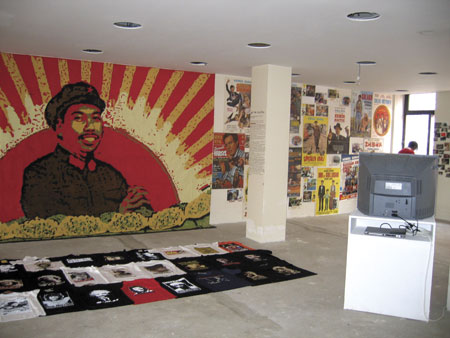
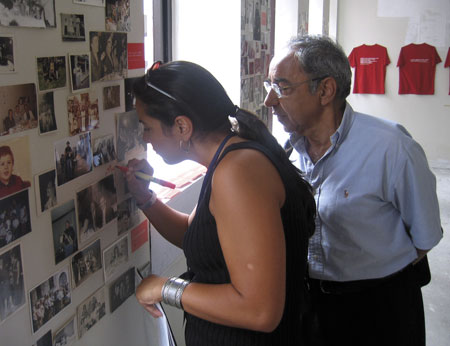
Ruangrupa, “Kaos,” 2005.
Research project for the 9th International Istanbul Biennial, which located and
compared a local hero in Istanbul with a local hero from Jakarta.
T-shirts, digital prints & video, dimensions variable. Courtesy of Ruangrupa.
Act 3: The Faroe Islands, May 12 – June 4, 2006
SPOKEN WORD/PERFORMANCE/MUSIC EVENT
Reinventing the Postcolonial Self
The Nordic House, Tórshavn
May 13, 2006, 5 pm – 12 am
This spoken word/performance/music event introduces artists, who use language and performance to reformulate identity and experience. Their work resists dominant, categorical models for the personal, the social, and the political and illustrates how these models relate to colonial legacies today. [Simultaneous interpretation will be available]
PARTICIPATING ARTISTS/PERFORMERS/MUSICIANS
Anida Yoeu Esguerra (Cambodia/USA)
Imani Henry (The Caribbean/USA)
Jane Jin Kaisen & Tobias Hübinette (South Korea/Denmark & South Korea/Sweden)
HYDROXYBROMIDE (Indonesia)
200 (The Faroe Islands)
Address/Admission:
Norðari Ringvegur, 100 Tórshavn
t: +298 35 13 51, e: nlh@nlh.fo, www.nlh.fo
Admission: adults DKK 100, children under 12 years free,
pensioners/students/groups of ten DKK 50
Program (download program here):
5 –6:30 pm: “(Dis)ComfortAN(d)AlieNation: The X-Raced Mut(at)ed Speak,” a multimedia performance written and performed by Jane Jin Kaisen (Interdisciplinary Artist and Activist) & Tobias Hübinette (Lecturer and Researcher at the Department of Oriental Languages, Stockholm University, Sweden).
6:30 – 6:45 pm: DJ Intermission with the duo HYDROXYBROMIDE (The duo counts members from Ruangrupa, and artists’ initiative and collaborative platform based in Jakarta, Indonesia).
6.45 – 7:45 pm: “On The Cusp of Phoenix Rising,” a poetry and performance piece written and performed by Anida Yoeu Esguerra (Multidisciplinary and Interdisciplinary Artist based in Chicago, USA).
7:45 – 8:30 pm: Food & Drinks Break with HYDROXYBROMIDE DJ’ing.
8:30 – 9:15 pm: “Living in the Light,” a multimedia theater piece written and performed by Imani Henry (Activist, Writer, and Performer based in New York, USA).
9:15 – 9:30 pm: DJ Intermission with HYDROXYBROMIDE.
9:30 – 10:30 pm: Concert with 200 (Pro-independence Punk-Rock band based in Tórshavn, The Faroe Islands).
10:30 pm – 12 am: Dance party with HYDROXYBROMIDE DJ’ing.
ANIDA YOEU ESGUERRA
Born 1973 in Cambodia. Lives and works in Chicago, USA.
Anida Yoeu Esguerra seeks an artistic, spiritual, and political exploration of her identity as a non hyphenated Cambodian Muslim American woman. Esguerra is a multidisciplinary and interdisciplinary artist who believes in pushing artistic and political boundaries. She creates art that mixes the visual, spoken, and written into performed investigations of hybrid identities. She is interested in using performance work as a means to transform losses into conversations about healing and understanding. She is a founding member of the critically acclaimed panAsian American spoken word quartet, I Was Born With Two Tongues, as well as Mango Tribe, an Asian American women’s performance ensemble. Esguerra tours extensively in North America with recent international performances in Delhi, Ho Chi Minh City, Phnom Penh, and Chiang Mai. Esguerra is co-editor of Screaming Monkeys: Critiques of Asian American Images (Coffee House Press, 2003) and ForeWord Magazine’s Gold Book of the Year. In 2002, Esguerra was recognized by PoliticalCircus.com as one of the 30 most influential Asian Pacific Americans 30 years of age or younger. Esguerra’s continued cultural work within the development of dialogue concerning social justice and human rights earned her Insight Arts’ Creative Movements Award for Spoken Word/Poetry. Esguerra is currently embarking on an international tour of “Living Memory/Living Absence,” an interdisciplinary performance/installation that explores memory, exile, and the pain of these experiences within the bodies of Cambodian genocide survivors. She aches for home, a good pair of ass-kicking shoes, and poetry by Audre Lorde. She is proud to call Chicago home but knows the journey never really ends for the refugee. For more information, visit www.atomicshogun.com.
Anida Yoeu Esguerra participates with the performance “On The Cusp of Phoenix Rising,” which is a combination of poetry and performance with one mic, one stage, and one wall. This show is a collection of Esguerra’s poetry and performance works. The show is an arsenal of work ranging from her most fierce poems to her most vulnerable monologues; from raw spoken word favorites such as “Excuse Me, ameriKa” and “The Day After 9/11” to the experimental fusion of poetry, video, and sound in “In Time of War.” Esguerra also performs excerpts from her recent show “Living Memory/Living Absence,” an interdisciplinary exploration of memory, exile, and the pain of these experiences within the bodies of Cambodian genocide survivors. Whether through humor, wit, anger, or just honest storytelling, “On the Cusp of Phoenix Rising” is a reflection of Esguerra’s hybrid cultural experiences as she struggles to find the juncture of her artistic, spiritual, and political identities. The pieces in this set change depending on audience, current issues, and what the moment requires. In fall 2006, Esguerra will release a full length CD based on the same name and body of work. [Anida Yoeu Esguerra]
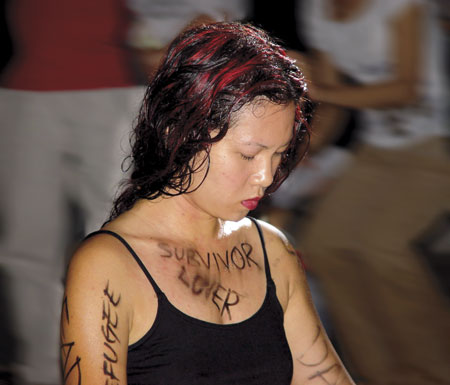
Anida Yoeu Esguerra performs “Pushing Through Borders”
in Ho Chi Minh City at Blue Space Gallery.
Photo: © Jorg Loschmann. Courtesy of the artist.
IMANI HENRY
Born in the Caribbean. Lives and works in New York, USA.
Imani Henry is an activist, writer, and performer. Since 1993, he has been a Staff Organizer at the International Action Center (IAC), where his work has focused on national organizing of communities of color and the lesbian, gay, bisexual, and transgender movement toward broader social justice campaigns. His anti-war activism has ranged from opposing US military inventions in Iraq, Haiti, Somalia, Venezuela, Colombia, and Yugoslavia to fighting to end the economic blockade of Cuba. He has worked nationally within the anti-police brutality and anti-death penalty movements as well as fighting for the freedom of all political prisoners incarcerated by the US government. Henry is the co-founder of Rainbow Flags for Mumia, a coalition of LGBTST people who demand the freedom of African-American political prisoner and journalist Mumia Abu Jamal. Henry’s writing has appeared in several publications, including the Lambda Award-winning Does Your Mama Know and the IAC publication War in Colombia: Made in USA. Henry was a featured commentator on the March 2005 segment of the nationally syndicated PBS monthly newsmagazine in the Life “American Gender” hosted by RuPaul. Henry’s multimedia theater piece, “B4T” (before testosterone), received an Honorable Mention for Best Play for the Downtown Urban Theater Festival performed at the Cherry Lane Theater in New York, June 2005. Currently, Imani Henry is the Program Coordinator of TransJustice, the first by and for Trans and Gender Non-Conforming People of Color political group of New York.
West Africa, Kingston, Port au Prince, Havana, and Brooklyn, New York, create the legacy of “Living in the Light;” a new multimedia theater piece that Imani Henry has written and will perform during Rethinking Nordic Colonialism. In this solo work, Henry calls forth cane field memories of slavery while walking down the sidewalks of Brooklyn’s Flatbush area; an area he calls home. Henry documents living and breathing inside the largest Caribbean community in the US juxtaposed with historic figures and images of slavery and colonization of the Caribbean. He explores the specific multinational, African, immigrant communities that shape Flatbush, Brooklyn and depicts how people co-exist in this neighborhood. Multimedia footage includes documentary interviews with people from the neighborhood. Henry portrays several characters, both women and men, as he tells present day stories and stories of the past. This interactive, cabaret-style theater performance invites the audience to become part of the show as they bear witness to this story unfolding. Still a work-in-progress, “Living in the Life” was developed in residence at the Brooklyn Arts Exchange (BAX) debuting in May 2004 and then featured at The Griot: Artists of Color Festival in June 2004. [Imani Henry]
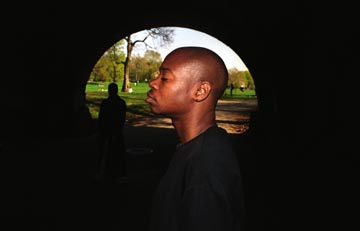
Imani Henry performing “B4T,” 2005. Photo: © Craig Bailey/CBE Photo. Courtesy of the artist.
JANE JIN KAISEN & TOBIAS HÜBINETTE
Born 1980 in Seoul, South Korea. Lives and works in Copenhagen, Denmark.
Born 1971 in Cheonju, South Korea. Lives and works in Stockholm, Sweden.
Jane Jin Kaisen is a visual artist and activist working in an interdisciplinary manner with video, performance, text, and photography. In an attempt to deconstruct narration, reading, and representation, she uses reversed strategies and multilayered approaches in her use of language and medium. She is part of Chamber of Public Secrets, a mobile art apparatus that produces video documentaries/broadcasting for the Copenhagenbased tv-tv and has organized Made In Video: International Video Art Festival on Public Secrets and Visual Representation in Copenhagen, 2006. She was co-curator of International Adoptee Gathering Exhibition (Seoul, South Korea, 2004), co-founder of UFOlab (Unidentified Foreign Object Laboratory), a Scandinavian-based artist/activist group working with postcolonial and feminist theory for international adoptees’ rights through seminars, exhibitions, city interventions, and writing. Kaisen is also part of the exhibition collective Orientity of Diaspora Korean Artists, which exhibits and lectures on trans-experience.
Tobias Hübinette (Korean name Lee Sam-dol) is a Lecturer and Researcher in contemporary Korean culture and society at the Department of Oriental Languages, Stockholm University. His Ph.D. dissertation in Korean Studies, Comforting an Orphaned Nation, examines international adoption from Korea, the Korean adoption issue, and representations of adopted Koreans in Korean media and popular culture. He has lectured, published books and articles, and made research on Nazism and racism in the Scandinavian countries. In addition, he writes in Swedish, Korean, and international newspapers and journals on issues concerning (post)colonialism in a Nordic context and setting, and on international adoption and international adoptees in general. Other interests are Swedish and Western images and representations of Korea and East Asians, problems regarding Orientalism and Asianists, and marginalized postcolonial Diasporas and ethnic minorities.
Jane Jin Kaisen & Tobias Hübinette participate with a new multimedia performance in two parts. Part 1 is performed in the Faroe Islands Art Museum on May 12 during the exhibition opening (see pages 62-63). Part 2, “(Dis)ComfortAn(d)AlieNation: The X-Raced Mut(at)ed Speak,” is performed in the Nordic House on May 13. The performance is closely related to Kaisen & Hübinette’s multimedia installation in Act 3’s exhibition titled “Tracing Trades” (click here for more info). Kaisen & Hübinette describe the performance as follows: “A performance testimony and lecture will suggest different forms of conscious resistance, reconstruction, and healing, and contest how Nordic neo-colonialism is perceived in the specific geographical location of the Faroe Islands by exploring the repression of the Scandinavian region’s colonial effects on transracial, transnational, and transcultural adoptees. Although the lack of cultural and ethnic heritage has led to the ‘successful’ assimilation and acculturation of international adoptees, surveys in the Scandinavian contexts reveal severe internalized conflicts. These psychic antagonisms deal with issues of loss and (be)longing mixed with feelings of being ‘unthankful’ or marginalized, if they speak out their dilemma of being ‘forced in-betweens’ without any place to return to. After decades of having been generalized, politicized, represented, and spoken for, we attempt to speak this unique experience of alienation and deprivation, regaining and reclaiming agency through art, cultural production, and academic research.” [Jane Jin Kaisen & Tobias Hübinette]
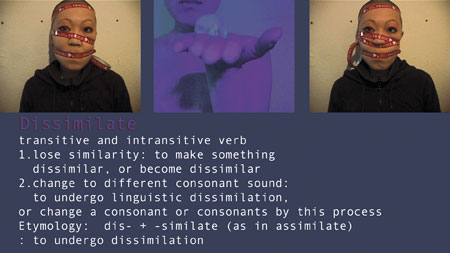
Jane Jin Kaisen, “Dissimilate & Transgress,” 2005.
Video stills from performance in Copenhagen, May, 2005.
Courtesy of the artist.
HYDROXYBROMIDE
Founded in 2004. Based in Jakarta, Indonesia.
HYDROXYBROMIDE is a DJ duo consisting of Ade Darmawan and Reza Afisina, both members of the Jakarta-based artists’ initiative and collaborative platform, Ruangrupa. The duo was founded in 2004 and has had several gigs in Jakarta.
Ruangrupa started to have “music” at their openings in 2000. The concept was simple: two CD-players and one mixer connected to a radio/tape sound system in a very little room. All guests were invited to guest DJ, allowing for a wide range of songs and varieties. The whole idea was to have some form of experimental entertainment that would bring many people together in Ruangrupa’s space even though they had never heard about the artists’ initiative and its programs before. This concept has continued, and many people now consider Ruangrupa to be a disco place with an exhibition space as well. But HYDROXYBROMIDE not only DJs, their gigs also count live acoustic music, karaoke, classical recital, and contemporary poetry readings. It is a cheap and alternative “dance floor” experience. [HYDROXYBROMIDE]
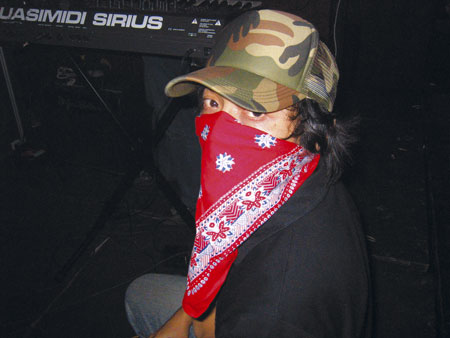
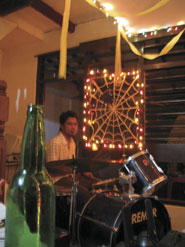
HYDROXYBROMIDE... Wish you could dance better at the next event!”.
Courtesy of HYDROXYBROMIDE.
200
Formed in 1996. Based in Tórshavn, The Faroe Islands.
200 (Tveyhundrað) was formed in 1996 for the compilation “Rock í Føroyum 2.” Niels Arge Galán, Uni Árting, and Mikael Blak were all members of the rock band Mold and wanted to do something different. To begin with, 200 was a side project with the purpose to prove that “alternative” rock could be sung in Faroese. At the time, almost all Faroese rock bands sang in English.
There wasn’t much activity after “Rock í Føroyum 2.” 200 was put on a shelf for a couple of years. But after Mold became history, 200 reemerged. 200 participated in Prix Føroyar, a band contest in 2001, and it wasn’t until then that the current “200” sound was established. The Elvis voice, the political lyrics, and the musical style all came together during this period. This was also the Year of the Gimp.
In 2001, 200 released its first album, “200%.” Although the airborne media totally ignored the release, it got very good reviews and finally sold out. The fact that it sold out came as a complete surprise to the band. At the time, Uni and Niels were living in Copenhagen and Mikael in the Faroe Islands. Activities were sparse, although performances were made in the Faroe Islands, Iceland, and Denmark.
After a while, concerts started to be embarrassing, as the material was getting older and older. The decision was made to record again. With all members together in the Faroe Islands, the decision was easy. In March 2005, “Viva la Republica” was recorded and released subsequently. Reviews were even better than “200%,” and the song “Muscleman-blað” was at the number one spot of the national official hit list. The world is a weird place…
200’s music is mostly about Faroese politics. With satirical lyrics, subjects like Faroese independence from the Danish Empire, homophobia, and Christian fundamentalism are portrayed in a different angle. When asked why the lyrics are political, the answer is simply: That is what is on our minds. Thus, the music is a tool to get our opinions across. In our opinion, too few people speak their minds in the Faroe Islands (this excludes all the nuts writing angry letters in the papers). Many things in the Faroe Islands are fxxxed up, and somebody has to say it… [200]
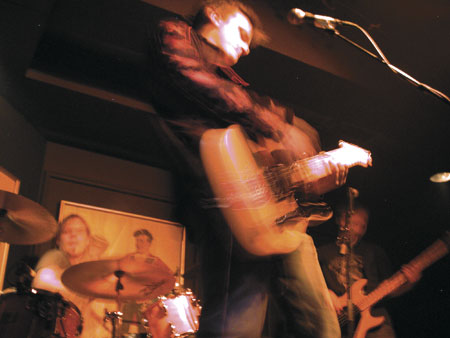
200 live. Photo: © Philippe Carré. Courtesy of 200.
